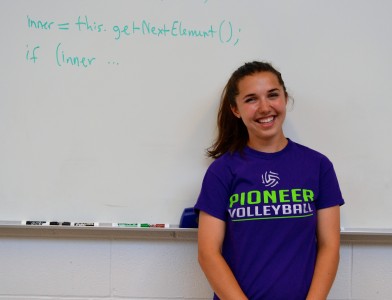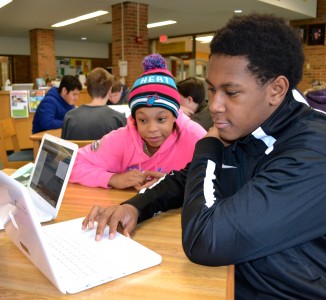
By Jo Mathis
AAPS District News Editor
Rachel Menge has known for a while that after graduating from Pioneer High, she would go into engineering.
It wasn’t until she enrolled in Ted Emch’s computer science class this year that the software vs. hardware debate was settled.
“This class was super influential in helping me decide what I want to do in college,” said the 2015 PHS graduate who will enter the University of Michigan College of Engineering to focus on computer science. “There is nothing that beats the feeling of working on code for days and then finally figuring out the problem you had, and seeing it work, and even if it’s just a little phrase pop up on the screen, it’s so rewarding.”

More and more, computer coding is taught at schools across the country, and AAPS is on top of the trend.
In addition to Pioneer’s well established computer science curriculum, Huron and Community high schools this year both started offering computer science classes while Skyline was able to add the Project Lead the Way computer science course to the Design, Technology & Environmental Planning (DTEP)Magnet with a grant from IMRA and the Ann Arbor Public Schools Educational Foundation.
In addition, the district has encouraged elementary and middle schools to use resources from Code.org’s Hour of Code and Google’s Made with Code to expose younger students to coding, as well.
Parent demand led to the first computer science course at Pioneer six years ago. Because science teacher Ted Emch had earned a degree in computer science education in 1995, he was tapped to design and teach the class.
“The kids loved it,” Emch said. “They just went nuts.”
By the next year, the class of nine expanded to 30. The following year, there were two sections of the course, and the year after that, there were three.
An AP course was added in 2013.
Is computer science a tough course?
“It isn’t trivial,” Emch says. “But anything that you do with the computer that’s really fun takes some work. There’s an up front investment that you have to make. But what you learn from it far outweighs the sometimes bit of frustration you sometimes feel when you’re trying to figure out what you’re doing.”

LeeAnn Dickinson-Kelley, assistant superintendent for instruction and student support services, says Emch has done a remarkable job transforming a class that reflects the best in 21st century learning.
“He is teaching computing/technology skills that will open a wealth of future opportunities for our students,” she said. “The class has grown to one of the most popular offered at Pioneer High School.”
The skills learned through coding go beyond software and hardware, said Merri Lynn Colligan, executive director of instructional technology and information services.
“The computational thinking learned in these courses provide students the skills to reason about systems and problems which will service them across many disciplines,” she said.
About two-thirds of the CS students at Pioneer are male, and each year there is a new push to encourage more girls to get into programming.
“A lot of kids, both male and female, don’t really know what computer science is,” Emch said. “It’s sort of shrouded in mystery. `What exactly do you do in that class? What does it mean?’”
While teens and their parents know how to use apps that other people have created, few know how to create their own applications, said Emch, whose students become both users and creators.
Learning computer science teaches students to think in a totally different way than any other course, he said.
“And that’s because the computer itself is so unforgiving,” said Emch. “It doesn’t have any ability to infer what you mean when you’re giving it a set of instructions. If everything isn’t exactly right, you get nothing. So it teaches you how to break things down in very small steps and pay attention to details like semicolons and periods, while at the same time, being creative about how it is we need to go about solving this problem in the first place. How can I teach something that knows absolutely nothing how to take 10 numbers and put them in order? Or how to take the pixels of a digital photograph and flip them around so the image is reversed. These are all things computers can do very quickly and easily, but they don’t know how to do them on their own. Somebody had to write the code to tell them how to do that.”
The first semester of computer science is devoted to learning Java, so those kids who go on to the AP course are very well prepared. Students create apps for Android devices using MIT App Inventor software, and can use the classroom Android phones to test their apps in real time. If they like how it turns out, they can upload their apps to the Google Play store and earn a few dollars.
The students also programmed Lego robots.
The AP course has a list of mandated requirements that comes from the College Board, and there are two required labs: a digital picture lab, and Chatbot.
CS is a math department elective, which is why many of the students are upperclassmen who’ve completed their required math courses.
Emch this year taught four computer science classes, and one chemistry class. But starting next year, he’ll teach five computer science classes.
“We go to four different high school coding competitions around southeastern Michigan and they have so much fun doing that,” said Emch. “The Facebook posts and tweets they send out are the kinds of things that create the draw. I’ve been blessed with wonderful, wonderful kids who want to take this class. And that’s at least 50 percent of the equation.”

When Jennifer Hein became principal of Huron High School this school year, adding computer science back to the curriculum was a top priority.
Huron CS teacher Kevin Behmer noted that the classes were very well received this year, and will be even more so when an AP section is added in the fall.
“We are fortunate to have a lot of opportunities around town to expose kids to STEM based materials and computer science is no different,” he said. “We have written apps for Android devices, and programmed robots to maneuver about the room giving/receiving feedback from the physical world.”
Hein noted that 49 students finished CS this year. Next year, the numbers increase to 39 in Java, with another 40 have signed up for AP computer science. In addition, 68 students are signed up for PLTW Introduction to Engineering, and 53 for Principles of Engineering.
Emch said it’s fascinating to watch the kids who come into the class knowing nothing about coding, and discovering they not only like it, but have a real knack for it.
“Anybody can learn to do it, but for some reason, some people just—bam. They get it and they love it,” said Emch, who has received email from students telling him that because of the class, they are now majoring in computer science.

Emch said that every step of the way, AAPS has recognized the importance of computer science education.
“Before this year, I was teaching all these courses off that cart right there in my chemistry lab,” he said, noting that Colligan helped secure him a dedicated space as well as the necessary computers.
This year, 132 Pioneer students took computer science.
Emch said there are so many graduation requirements now, it’s tough to fit in an elective. He thinks computer science in some way or another should be required of all high school students, whether college-bound or not.
“Either you integrate it into a math course they’re already required to take or you leave it as a stand-alone course kids take for a semester, maybe opposite health or something else.”
Understanding what it takes to interact with a machine is a 21st Century skill, said Emch, whose students also discuss the ethics involved in emerging technology.
He also is a big believer in having kids work on teams, insisting that those in the field have told him: “It’s great if the kids can code. It’s even better if they can code with another person.”
Rachel Menge said the CS course not only influenced her career goals, it gave her more in common with her father, a computer software engineer.
“He does programming as well, but we never really talked about software until after this class” she said. “And it’s all we talked about at dinner! My poor mother. It was all about coding.”


Be the first to comment